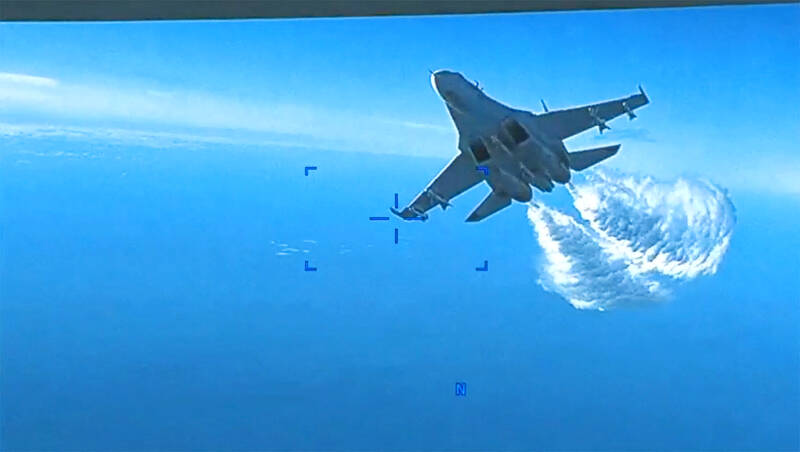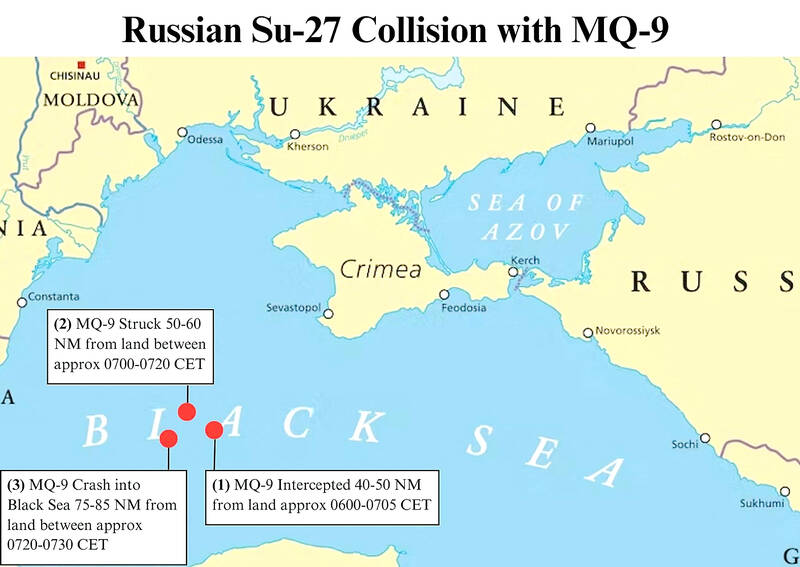The administration of US President Joe Biden on Thursday released video footage showing a Russian fighter jet dumping fuel on a US Air Force surveillance drone.
The release came as the US sought to hold Russia responsible for a collision that led to the drone’s crash into the Black Sea without escalating fraught tensions with the Kremlin.
The US military declassified a 42-second color video showing a Russian Su-27 approaching the back of the MQ-9 Reaper drone and releasing fuel as it passes, the Pentagon said.

Photo: AFP / USEUCOM
Dumping the fuel appeared to be aimed at blinding the drone’s optical instruments to drive it from the area.
On a second approach, either the same jet or another Russian Su-27 that had been shadowing the MQ-9 struck the drone’s propeller, damaging a blade, the US military said, adding that it then ditched the aircraft in the sea.
The video excerpt does not show the collision, although it does show the damage to the propeller.

Photo: REUTERS
Russia said its fighters did not strike the drone and claimed the uncrewed aerial vehicle went down after making a sharp maneuver.
While calling out Russia for “reckless” action, the White House tried to strike a balance to avoid exacerbating tensions.
US officials said they have not been able to determine whether the Russian pilot intentionally struck the drone, adding that lines of communication with Moscow remain open.
“I can’t point to that video and say this is a deliberate attempt to escalate or ... tangibly bring about [Russian President Vladimir] Putin’s false claim that this is about the West versus Russia,” US National Security Council spokesman John Kirby said. “We have made clear on many occasions, we do not seek a conflict with Russia.”
Putin has said that by providing weapons to Ukraine and sharing intelligence with Kyiv, the US and its allies have effectively become engaged in the Ukraine war.
Russian Security Council Secretary Nikolai Patrushev on Wednesday said that an attempt would be made to recover the drone’s debris.
US officials have expressed confidence that nothing of military value would remain from the drone even if Russia retrieved the wreckage.
They left open the possibility of trying to recover part of the downed US$32 million aircraft, which they said crashed into waters that were up to to 1,500m deep, although the US does not have any ships in the area.
Russia and NATO member countries routinely intercept each other’s warplanes, but Tuesday’s incident marked the first time since the Cold War that a US aircraft went down during such a confrontation, raising concerns it could bring Moscow and Washington closer to a direct conflict.

Kehinde Sanni spends his days smoothing out dents and repainting scratched bumpers in a modest autobody shop in Lagos. He has never left Nigeria, yet he speaks glowingly of Burkina Faso military leader Ibrahim Traore. “Nigeria needs someone like Ibrahim Traore of Burkina Faso. He is doing well for his country,” Sanni said. His admiration is shaped by a steady stream of viral videos, memes and social media posts — many misleading or outright false — portraying Traore as a fearless reformer who defied Western powers and reclaimed his country’s dignity. The Burkinabe strongman swept into power following a coup in September 2022

‘FRAGMENTING’: British politics have for a long time been dominated by the Labor Party and the Tories, but polls suggest that Reform now poses a significant challenge Hard-right upstarts Reform UK snatched a parliamentary seat from British Prime Minister Keir Starmer’s Labor Party yesterday in local elections that dealt a blow to the UK’s two establishment parties. Reform, led by anti-immigrant firebrand Nigel Farage, won the by-election in Runcorn and Helsby in northwest England by just six votes, as it picked up gains in other localities, including one mayoralty. The group’s strong showing continues momentum it built up at last year’s general election and appears to confirm a trend that the UK is entering an era of multi-party politics. “For the movement, for the party it’s a very, very big

ENTERTAINMENT: Rio officials have a history of organizing massive concerts on Copacabana Beach, with Madonna’s show drawing about 1.6 million fans last year Lady Gaga on Saturday night gave a free concert in front of 2 million fans who poured onto Copacabana Beach in Rio de Janeiro for the biggest show of her career. “Tonight, we’re making history... Thank you for making history with me,” Lady Gaga told a screaming crowd. The Mother Monster, as she is known, started the show at about 10:10pm local time with her 2011 song Bloody Mary. Cries of joy rose from the tightly packed fans who sang and danced shoulder-to-shoulder on the vast stretch of sand. Concert organizers said 2.1 million people attended the show. Lady Gaga

SUPPORT: The Australian prime minister promised to back Kyiv against Russia’s invasion, saying: ‘That’s my government’s position. It was yesterday. It still is’ Left-leaning Australian Prime Minister Anthony Albanese yesterday basked in his landslide election win, promising a “disciplined, orderly” government to confront cost-of-living pain and tariff turmoil. People clapped as the 62-year-old and his fiancee, Jodie Haydon, who visited his old inner Sydney haunt, Cafe Italia, surrounded by a crowd of jostling photographers and journalists. Albanese’s Labor Party is on course to win at least 83 seats in the 150-member parliament, partial results showed. Opposition leader Peter Dutton’s conservative Liberal-National coalition had just 38 seats, and other parties 12. Another 17 seats were still in doubt. “We will be a disciplined, orderly